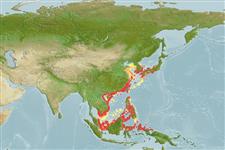Classification / Names
Common names from other countries
Main reference
Size / Weight / Age
Max length : 60.0 cm TL male/unsexed; (Ref. 56557); common length : 30.0 cm TL male/unsexed; (Ref. 27773); max. published weight: 140.00 g (Ref. 4883)
Environment
Marine; brackish; pelagic-neritic; depth range 5 - ? m (Ref. 12166)
Climate / Range
Tropical, preferred 23°C (Ref. 107945); 39°N - 1°S, 103°E - 138°E (Ref. 54449)
Distribution
Indo-Pacific: Indian Ocean (Kuwait Bay and Pondicherry), Java Sea (Singapore), East China Sea (Canton north to the Koreas and southern Japan, as far as Osaka on the Pacific coast and Fukuoka in Sea of Japan, also Peter the Great Bay in Soviet waters).
Countries | FAO areas | Ecosystems | Occurrences | Introductions
Short description
Dorsal
spines
(total): 0;
Anal
spines: 0;
Anal
soft rays: 43 - 53. Body slender, belly with usually 24 to 25 + 10 to 15, total 34 to 42 scutes. Eye large, lower jaw projecting. Dorsal fin origin at about midpoint of body or a little behind; anal fin origin a little behind dorsal fin base. Swim bladder with a long tube passing back down right side of body above anal fin base.
IUCN Red List Status (Ref. 115185)
Threat to humans
Harmless
Human uses
Fisheries: highly commercial
More information
ReferencesAquacultureAquaculture profileStrainsGeneticsAllele frequenciesHeritabilityDiseasesProcessingMass conversion
Tools
Special reports
Download XML
Internet sources
Estimates of some properties based on models
Phylogenetic diversity index
PD50 = 0.5000 many relatives (e.g. carps) 0.5 - 2.0 few relatives (e.g. lungfishes)
Trophic Level
3.8 ±0.61 se; Based on food items.
Resilience
High, minimum population doubling time less than 15 months (Assuming tm=1-2)
Vulnerability
Moderate vulnerability (35 of 100)
Price category
